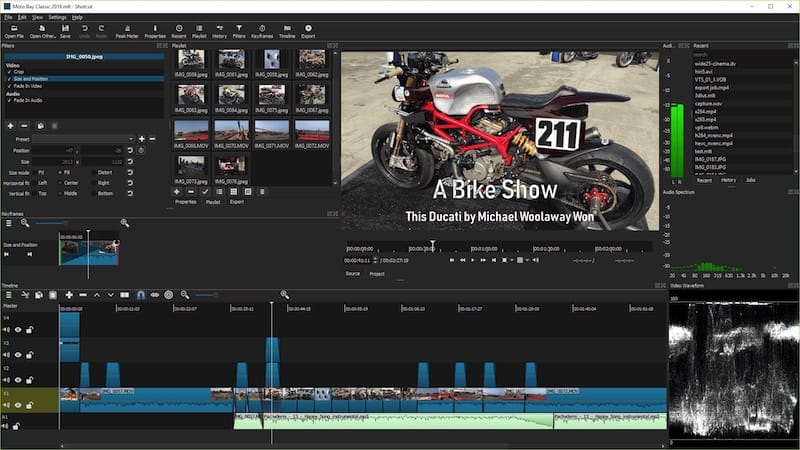How To Install Shotcut on AlmaLinux 9

In the world of video editing, having a reliable and feature-rich software is crucial for content creators, professionals, and hobbyists alike. Shotcut, a powerful open-source video editor, has gained popularity among Linux users for its versatility and user-friendly interface. This guide will walk you through the process of installing Shotcut on AlmaLinux 9, a robust and stable Linux distribution that serves as an excellent platform for video editing tasks.
AlmaLinux 9, known for its stability and compatibility with enterprise-grade software, provides an ideal environment for running Shotcut. Whether you’re a seasoned video editor or just starting your journey in content creation, this tutorial will help you get Shotcut up and running on your AlmaLinux 9 system.
What is Shotcut?
Shotcut is a free, open-source, and cross-platform video editing software that offers a wide range of features for both beginners and advanced users. It supports a variety of video formats and provides a non-linear editing experience, allowing users to work with multiple video and audio tracks.
Key features of Shotcut include:
- Support for a wide range of video, audio, and image formats
- Multi-track timeline for complex video compositions
- Built-in screen and webcam capture
- Advanced audio filters and mixing capabilities
- Keyframe animation for dynamic effects
- Customizable user interface
- GPU-accelerated processing for improved performance
Using Shotcut on AlmaLinux 9 offers several advantages, including:
- Stability and reliability of the AlmaLinux platform
- Compatibility with enterprise-grade hardware
- Access to a wide range of open-source tools and libraries
- Long-term support and security updates
System Requirements
Before proceeding with the installation of Shotcut on AlmaLinux 9, ensure that your system meets the following requirements:
Hardware Requirements:
- 64-bit processor (x86_64)
- 4GB RAM (8GB or more recommended for HD/4K editing)
- OpenGL 2.0 compatible graphics card
- Sufficient storage space for video files and projects
Software Prerequisites:
- AlmaLinux 9 (fully updated)
- Internet connection for downloading packages
- Basic knowledge of terminal commands
Preparing AlmaLinux 9 for Shotcut Installation
Before installing Shotcut, it’s essential to update your AlmaLinux 9 system and install necessary dependencies. Follow these steps to prepare your system:
1. Update the System
Open a terminal and run the following command to update your system:
sudo dnf update -yThis command will update all installed packages to their latest versions, ensuring compatibility and stability.
2. Install Necessary Dependencies
Shotcut requires several libraries and dependencies to function correctly. Install them using the following command:
sudo dnf install -y mesa-libGL mesa-libGLU libXcomposite libXcursor libXi libXtst alsa-lib pulseaudio-libsThese packages provide essential graphics libraries, audio support, and system integration components required by Shotcut.
Methods to Install Shotcut on AlmaLinux 9
There are three primary methods to install Shotcut on AlmaLinux 9:
- Using Flatpak
- Using AppImage
- Compiling from source
We’ll explore each method in detail, allowing you to choose the one that best suits your needs and preferences.
Method 1: Installing Shotcut Using Flatpak
Flatpak is a universal package management system that allows for easy installation and management of applications across different Linux distributions. Here’s how to install Shotcut using Flatpak:
Step 1: Install Flatpak
If Flatpak is not already installed on your AlmaLinux 9 system, install it using the following command:
sudo dnf install -y flatpakStep 2: Add Flathub Repository
Flathub is the primary repository for Flatpak applications. Add it to your system with this command:
flatpak remote-add --if-not-exists flathub https://flathub.org/repo/flathub.flatpakrepoStep 3: Install Shotcut via Flatpak
Now, you can install Shotcut using the following command:
flatpak install flathub org.shotcut.ShotcutFollow the on-screen prompts to complete the installation. Once finished, you can launch Shotcut from your application menu or by running:
flatpak run org.shotcut.ShotcutMethod 2: Installing Shotcut Using AppImage
AppImage is a portable package format that allows you to run applications without installation. Here’s how to use Shotcut via AppImage:
Step 1: Download Shotcut AppImage
Visit the official Shotcut website (https://shotcut.org/download/) and download the latest AppImage for Linux.
Step 2: Make AppImage Executable
Open a terminal, navigate to the directory containing the downloaded AppImage, and make it executable:
cd ~/Downloads
chmod +x Shotcut-*.AppImageStep 3: Run Shotcut AppImage
Launch Shotcut by double-clicking the AppImage file in your file manager or by running:
./Shotcut-*.AppImageYou can move the AppImage to a convenient location and create a desktop shortcut for easy access.
Method 3: Compiling Shotcut from Source
For advanced users who want the latest features or need to customize the build, compiling Shotcut from source is an option. Here’s a brief overview of the process:
Step 1: Install Build Dependencies
Install the necessary build tools and dependencies:
sudo dnf groupinstall "Development Tools" -y
sudo dnf install -y qt5-qtbase-devel qt5-qtmultimedia-devel qt5-qtwebsockets-devel qt5-qtwebengine-devel qt5-qtsvg-devel qt5-qtx11extras-devel ffmpeg-devel SDL2-devel frei0r-devel lame-devel cmakeStep 2: Clone Shotcut Repository
git clone https://github.com/mltframework/shotcut.git
cd shotcutStep 3: Compile and Install
mkdir build && cd build
cmake ..
make
sudo make installThis method requires more time and technical knowledge but allows for customization and access to the latest development version.
Post-Installation Configuration
After installing Shotcut, it’s important to configure it for optimal performance:
Setting up Shotcut for First Use
- Launch Shotcut and navigate to “Settings” > “Video”.
- Set the default resolution and frame rate for new projects.
- Under “Settings” > “Audio”, configure your audio input and output devices.
- In “Settings” > “Performance”, adjust the GPU processing options based on your hardware capabilities.

Configuring Preferences
Explore the “Settings” menu to customize various aspects of Shotcut, including:
- Interface language and theme
- Keyboard shortcuts
- Autosave frequency
- Default export settings
Troubleshooting Common Issues
While Shotcut generally runs smoothly on AlmaLinux 9, you may encounter some issues. Here are solutions to common problems:
Dependency Problems
If you experience missing dependencies, try installing additional multimedia libraries:
sudo dnf install -y gstreamer1-plugins-base gstreamer1-plugins-good gstreamer1-plugins-bad-free gstreamer1-plugins-ugly-freePerformance Issues
If Shotcut runs slowly:
- Enable GPU processing in the settings if your hardware supports it.
- Lower the preview quality in the player to reduce resource usage during editing.
- Close unnecessary background applications to free up system resources.
Audio/Video Codec Issues
If you encounter problems with specific video or audio formats:
- Install additional codecs:
sudo dnf install -y ffmpeg-libs - Convert problematic files to a more compatible format using a tool like FFmpeg.
Updating Shotcut
Keeping Shotcut up-to-date ensures you have access to the latest features and bug fixes. The update process varies depending on your installation method:
Updating via Flatpak
To update Shotcut installed via Flatpak, run:
flatpak update org.shotcut.ShotcutUpdating AppImage
For AppImage installations, download the latest version from the official website and replace the existing AppImage file.
Updating from Source
If you compiled from source, navigate to the Shotcut directory, pull the latest changes, and recompile:
cd shotcut
git pull
cd build
cmake ..
make
sudo make installCongratulations! You have successfully installed Shotcut. Thanks for using this tutorial for installing the Shotcut video editor on your AlmaLinux 9 system. For additional or useful information, we recommend you check the official Shotcut website.